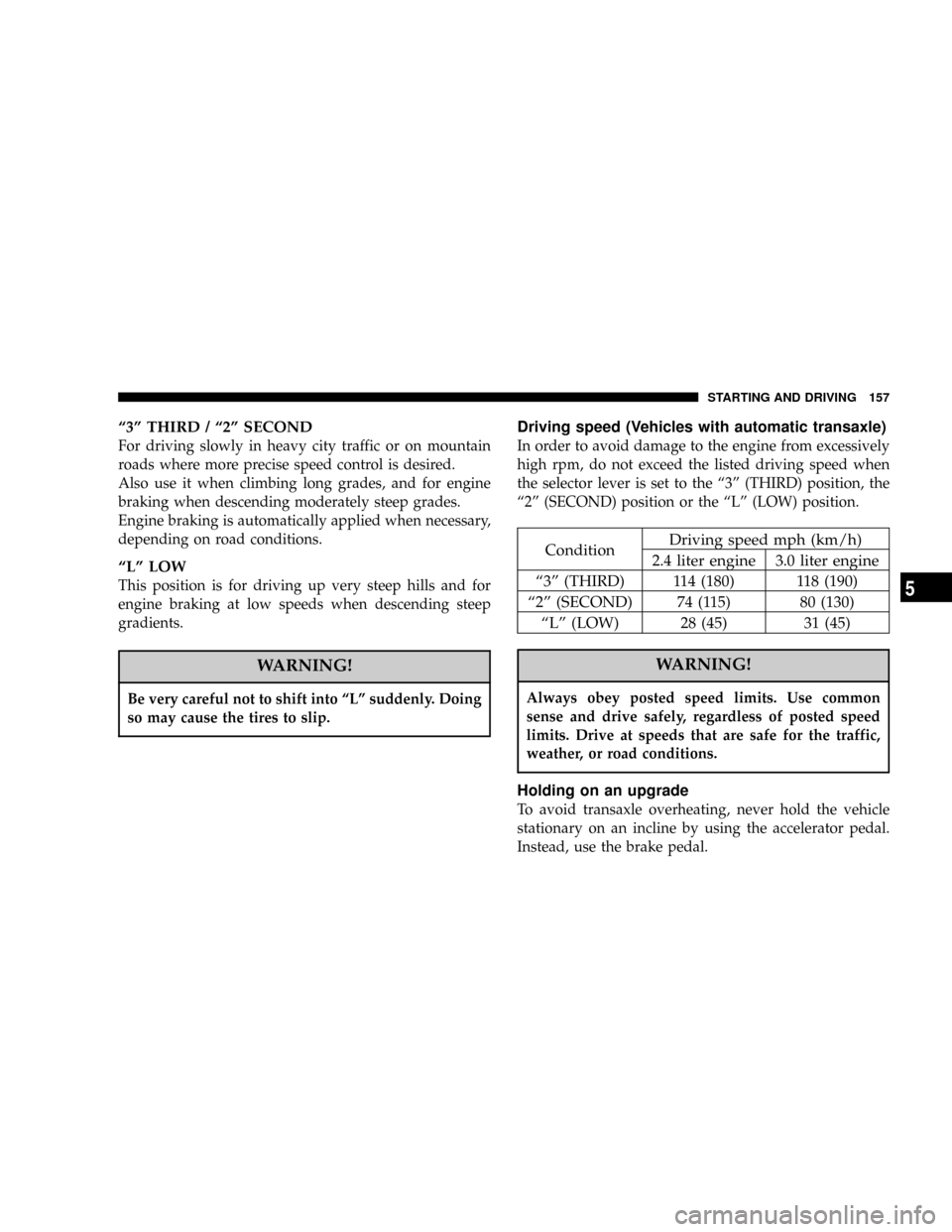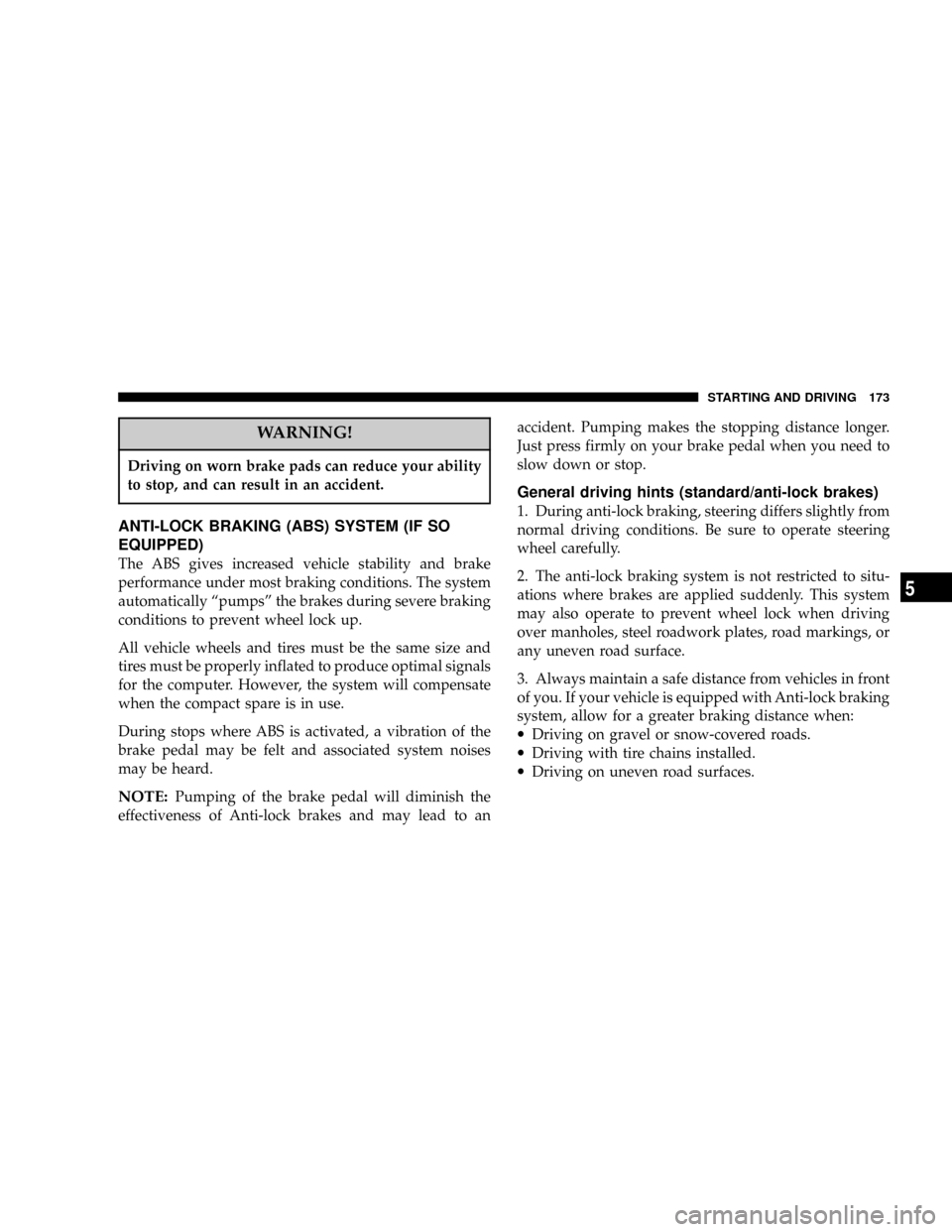Page 8 of 388
Outside
1. Engine compartment!p. 257
Engine hood!p. 412. Windshield wiper and washer!p. 126
3. Sunroof (if so equipped)!p. 46
4. Outside rear-view mirrors!p. 186
5. Whip antenna!p. 217
6. Front turn signal lights and parking lights
!p. 119, 295
7. Fog lights (if so equipped)!p. 120
8. Headlights!p. 119, 292
9. Front side marker lights!p. 298
10. Tire inflation pressure!p. 332
Changing tires!p. 268
Tire rotation!p. 336
Tire chains!p. 337
Wheel covers (if so equipped)!p. 266
11. Locking and unlocking!p. 26
Keyless entry system!p. 29
12. High-mounted stop lights!p. 300
13. Trunk lid!p. 35
14. License plate lights!p. 300
15. Back up lights!p. 291
16. Stop and tail lights!p. 291
17. Rear turn signal lights!p. 291
18. Rear side-marker lights!p. 291
19. Fuel filler!p. 39
8 INTRODUCTION
Page 143 of 388
mCruise/speed control....................189
NTo activate...........................190
NTo deactivate.........................194
NTo resume the set speed.................195
mTraction control (if so equipped)...........196
mCatalytic converter.....................197
mVehicle preparation before driving..........199
NSeat belts and seats....................199
NDefrosters...........................199
NTires...............................199NLights..............................200
NFluid leaks..........................200
NDriver..............................200
mSafe driving techniques..................200
mDriving, alcohol and drugs...............201
mTips for driving in various conditions........201
mOperation during cold weather............202
mTrailer Towing.........................203
NWarranty Requirements.................203
STARTING AND DRIVING 143
5
Page 149 of 388

FUEL ECONOMY
Fuel economy is dependent on many factors. Your per-
sonal driving habits can have a significant effect on your
fuel economy. Several recommendations for achieving
maximum fuel economy are listed below.
1. When pulling away from traffic lights or stop signs,
accelerate slowly and smoothly.
2. When parked for even a short period, do not idle the
engine. Shut it off.
3. Plan your trips to avoid unnecessary stops.
4. Keep your tires inflated to the recommended pres-
sures.
5. For freeway driving, maintain a constant speed within
the posted limits when traffic, roadway and weather
conditions safely permit, for the best fuel economy.
6. Keep your air filter clean and your vehicle lubricated
according to the recommendations in this manual.
7. Keep your vehicle ªtuned-upº.
An out-of-tune engine wastes fuel and costs money.
8. Reduce excess vehicle load.
IGNITION SWITCH
LOCK
For vehicles with a manual transaxle, when removing the
key, push the key in at the ªACCº position and keep it
depressed until it is turned to the ªLOCKº position, and
remove the key.
For vehicles with an automatic transaxle: When remov-
ing the key, first set the gear selector lever to the ªPº
(PARK) position, and then turn the key to ªLOCKº and
remove it.
I21A0230
STARTING AND DRIVING 149
5
Page 157 of 388

ª3º THIRD / ª2º SECOND
For driving slowly in heavy city traffic or on mountain
roads where more precise speed control is desired.
Also use it when climbing long grades, and for engine
braking when descending moderately steep grades.
Engine braking is automatically applied when necessary,
depending on road conditions.
ªLº LOW
This position is for driving up very steep hills and for
engine braking at low speeds when descending steep
gradients.
WARNING!
Be very careful not to shift into ªLº suddenly. Doing
so may cause the tires to slip.
Driving speed (Vehicles with automatic transaxle)
In order to avoid damage to the engine from excessively
high rpm, do not exceed the listed driving speed when
the selector lever is set to the ª3º (THIRD) position, the
ª2º (SECOND) position or the ªLº (LOW) position.
ConditionDriving speed mph (km/h)
2.4 liter engine 3.0 liter engine
ª3º (THIRD) 114 (180) 118 (190)
ª2º (SECOND) 74 (115) 80 (130)
ªLº (LOW) 28 (45) 31 (45)
WARNING!
Always obey posted speed limits. Use common
sense and drive safely, regardless of posted speed
limits. Drive at speeds that are safe for the traffic,
weather, or road conditions.
Holding on an upgrade
To avoid transaxle overheating, never hold the vehicle
stationary on an incline by using the accelerator pedal.
Instead, use the brake pedal.
STARTING AND DRIVING 157
5
Page 173 of 388

WARNING!
Driving on worn brake pads can reduce your ability
to stop, and can result in an accident.
ANTI-LOCK BRAKING (ABS) SYSTEM (IF SO
EQUIPPED)
The ABS gives increased vehicle stability and brake
performance under most braking conditions. The system
automatically ªpumpsº the brakes during severe braking
conditions to prevent wheel lock up.
All vehicle wheels and tires must be the same size and
tires must be properly inflated to produce optimal signals
for the computer. However, the system will compensate
when the compact spare is in use.
During stops where ABS is activated, a vibration of the
brake pedal may be felt and associated system noises
may be heard.
NOTE:Pumping of the brake pedal will diminish the
effectiveness of Anti-lock brakes and may lead to anaccident. Pumping makes the stopping distance longer.
Just press firmly on your brake pedal when you need to
slow down or stop.
General driving hints (standard/anti-lock brakes)
1. During anti-lock braking, steering differs slightly from
normal driving conditions. Be sure to operate steering
wheel carefully.
2. The anti-lock braking system is not restricted to situ-
ations where brakes are applied suddenly. This system
may also operate to prevent wheel lock when driving
over manholes, steel roadwork plates, road markings, or
any uneven road surface.
3. Always maintain a safe distance from vehicles in front
of you. If your vehicle is equipped with Anti-lock braking
system, allow for a greater braking distance when:
·Driving on gravel or snow-covered roads.
·Driving with tire chains installed.
·Driving on uneven road surfaces.
STARTING AND DRIVING 173
5
Page 174 of 388
CAUTION!
²Anti-lock braking system can not prevent acci-
dents. It remains the driver's task to exercise
safety precautions and to drive prudently.
²To prevent failure of the anti-lock braking system,
be sure all 4-wheels and tires are the same size
and type (space saver spare excluded).
²If the anti-lock brake system warning light illu-
minates after starting the engine or while driving,
it indicates that the anti-lock braking system is
not functioning and that only the normal brake
system is in operation. (The normal brake system
will still function properly.)
NOTE
1. After the vehicle is driven for a while a whining sound
and the sound of a motor operating will be heard from
the engine compartment. These are normal sounds of the
anti-lock braking system performing a self check and do
not indicate a malfunction.
2. The anti-lock braking system becomes operative after
the vehicle has accelerated to a speed over approximately
I24A1590
174 STARTING AND DRIVING
Page 196 of 388

procedure:
(1) The ignition key is turned OFF.
(2) The main switch is turned OFF.
TRACTION CONTROL (IF SO EQUIPPED)
On slippery surfaces, traction control system prevents the
drive wheels (front wheels) from excessive spinning,
during starting or while accelerating in turns on slippery
roads.
NOTE
²
The traction control system functions at speeds
below about 25mph (40km/h).
²Some vibration will be felt in the vehicle body and a
whining sound of a motor will be heard from the
engine compartment when the traction control sys-
tem functions. This is a normal result of the traction
control system operation, and does not indicate a
malfunction.
Driving hints
1. Traction control system does not actively apply brakes.
Always decelerate the vehicle sufficiently before entering
corners or bends.
2. On snowy or icy roads, drive slowly using tire chains
or snow tires.
3. Never mix or use tires of different size since the
traction control system could function incorrectly and
make safe driving difficult.
196 STARTING AND DRIVING
Page 199 of 388

8. Stop driving the vehicle if you think the performance
is noticeably less, or that there is unnecessary engine
miss, or any other engine trouble, such as with the
ignition, etc. If it is impractical to stop driving immedi-
ately, reduce the speed and drive for only a short time.
Have an inspection made by an authorized dealer as
soon as possible.
9. In an unusual event of a severe engine malfunction, a
scorching odor may indicate severe and abnormal cata-
lytic converter overheating. If this occurs, the vehicle
should be stopped in a safe place, the engine shut off and
the vehicle allowed to cool. Once the engine is cool, the
vehicle should immediately be taken to a dealer for
service.
VEHICLE PREPARATION BEFORE DRIVING
Before starting on a trip, perform the following checks to
obtain the greatest possible enjoyment and safety from
your vehicle:
Seat belts and seats
1. Before starting the vehicle, make certain that you and
all your passengers are seated and properly wearing the
seat belts (with children in the rear seat, in appropriate
restraints), and that all doors are locked.
2.
Adjust the driver's seat as far back as possible, while still
maintaining good visibility, and good control of the steering
wheel, brakes, accelerator, and controls. Examine the instru-
ment panel indicators for any possible malfunction.
3. Have the front passenger adjust their seat as far
rearward as possible.
Defrosters
Check operation by selecting the defroster mode and set
the blower switch for high speed operation. You should
be able to feel the air directed against the windshield.
(See ªHeater /Air conditioningº page 234.)
Tires
Examine all tires for excessive tread wear or uneven wear
patterns. Check for stones, nails, glass, or other objects
lodged in the tread. Inspect for tread cuts or sidewall
cracks.
STARTING AND DRIVING 199
5